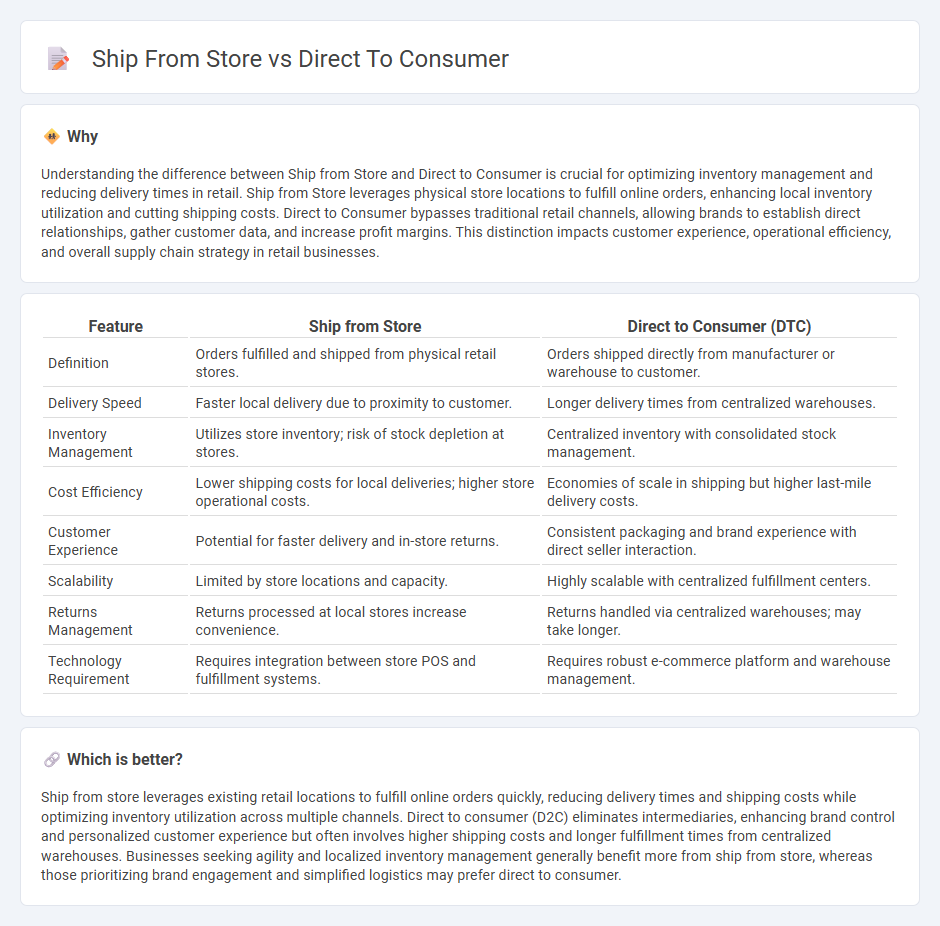
Ship from store optimizes inventory by fulfilling online orders directly from local retail locations, reducing shipping times and costs compared to traditional distribution centers. Direct to consumer (DTC) bypasses retailers and delivers products straight from the manufacturer to the customer, enhancing brand control and fostering stronger customer relationships. Explore the distinct advantages of ship from store versus direct to consumer strategies to boost retail efficiency and customer satisfaction.
Why it is important
Understanding the difference between Ship from Store and Direct to Consumer is crucial for optimizing inventory management and reducing delivery times in retail. Ship from Store leverages physical store locations to fulfill online orders, enhancing local inventory utilization and cutting shipping costs. Direct to Consumer bypasses traditional retail channels, allowing brands to establish direct relationships, gather customer data, and increase profit margins. This distinction impacts customer experience, operational efficiency, and overall supply chain strategy in retail businesses.
Comparison Table
| Feature | Ship from Store | Direct to Consumer (DTC) |
|---|---|---|
| Definition | Orders fulfilled and shipped from physical retail stores. | Orders shipped directly from manufacturer or warehouse to customer. |
| Delivery Speed | Faster local delivery due to proximity to customer. | Longer delivery times from centralized warehouses. |
| Inventory Management | Utilizes store inventory; risk of stock depletion at stores. | Centralized inventory with consolidated stock management. |
| Cost Efficiency | Lower shipping costs for local deliveries; higher store operational costs. | Economies of scale in shipping but higher last-mile delivery costs. |
| Customer Experience | Potential for faster delivery and in-store returns. | Consistent packaging and brand experience with direct seller interaction. |
| Scalability | Limited by store locations and capacity. | Highly scalable with centralized fulfillment centers. |
| Returns Management | Returns processed at local stores increase convenience. | Returns handled via centralized warehouses; may take longer. |
| Technology Requirement | Requires integration between store POS and fulfillment systems. | Requires robust e-commerce platform and warehouse management. |
Which is better?
Ship from store leverages existing retail locations to fulfill online orders quickly, reducing delivery times and shipping costs while optimizing inventory utilization across multiple channels. Direct to consumer (D2C) eliminates intermediaries, enhancing brand control and personalized customer experience but often involves higher shipping costs and longer fulfillment times from centralized warehouses. Businesses seeking agility and localized inventory management generally benefit more from ship from store, whereas those prioritizing brand engagement and simplified logistics may prefer direct to consumer.
Connection
Ship from store leverages retail locations as mini-fulfillment centers, enabling faster delivery by utilizing existing inventory close to customers. Direct to consumer (DTC) strengthens this model by emphasizing personalized, efficient service channels, reducing reliance on centralized warehouses and cutting shipping costs. Together, they optimize order fulfillment speed, inventory management, and customer satisfaction in omnichannel retail strategies.
Key Terms
Distribution Channel
Direct to consumer (DTC) distribution channels bypass traditional retailers, enabling brands to sell products directly through online platforms and physical stores, enhancing customer engagement and control over brand experience. Ship from store leverages existing retail locations to fulfill online orders, reducing delivery times and costs by utilizing inventory closer to the consumer. Explore further to understand which distribution model maximizes efficiency and customer satisfaction for your business.
Inventory Management
Direct to consumer (DTC) inventory management offers real-time stock tracking and reduces overhead by bypassing physical stores, enabling faster fulfillment and improved customer satisfaction. Ship from store leverages existing retail locations as mini-warehouses, optimizing inventory turnover and reducing shipping costs through localized distribution. Explore how these strategies impact supply chain efficiency and customer experience to optimize your inventory approach.
Order Fulfillment
Order fulfillment strategies such as direct-to-consumer (DTC) and ship-from-store play crucial roles in optimizing delivery speed and reducing shipping costs. DTC allows brands to ship products directly from warehouses to customers, ensuring inventory control and faster shipments, while ship-from-store leverages existing retail locations to fulfill online orders quickly, improving last-mile efficiency. Explore the differences between these fulfillment models to enhance your supply chain performance and customer satisfaction.
Source and External Links
Direct to Consumer (D2C) Guide - Direct to consumer means a brand sells its products straight to the end user without retail partners, commonly through ecommerce, social commerce, or apps, allowing manufacturers to grow sales and control customer relationships directly.
Direct-to-consumer - DTC (or D2C) is a business model that bypasses third-party retailers or wholesalers to sell directly to customers, mostly online, and includes brands like Warby Parker or Dollar Shave Club; it gained popularity with the internet and has roots in early commerce before modern transport.
What Is Direct-to-Consumer? Everything You Need To Know - The DTC retail model gives brands complete control over fulfillment and messaging by selling directly to consumers, building customer relationships through targeted experiences, loyalty programs, and customer insights, often emphasizing digital channels alongside select physical stores.
 dowidth.com
dowidth.com